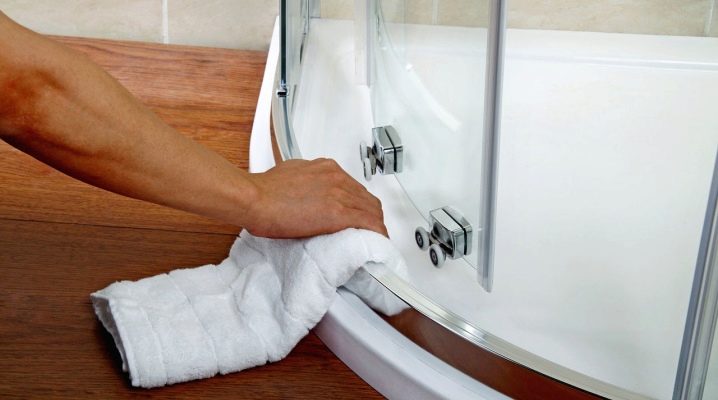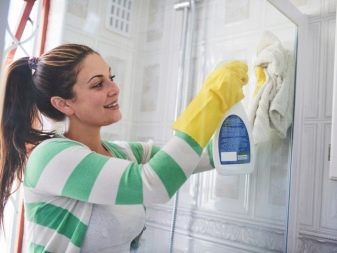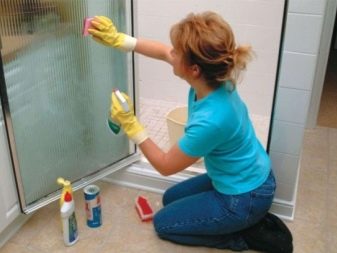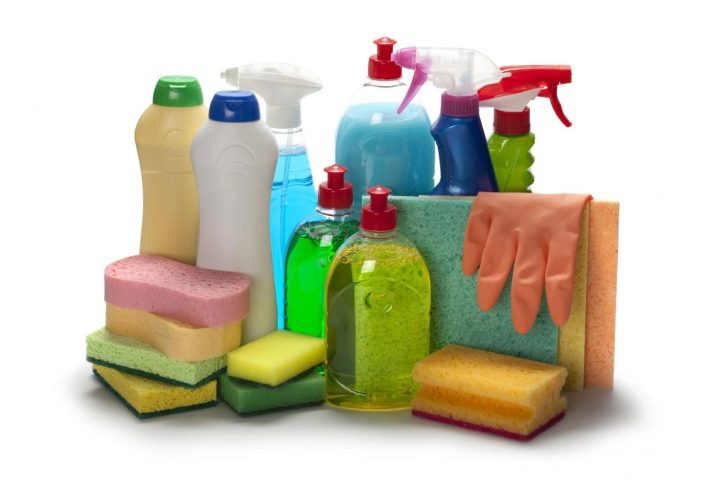How to clean the shower cabin from limescale at home?

Today, a shower stall is no longer a luxury. Nowadays, this is one of the most popular ways to organize a combined bathroom. The popularity is explained by such advantages of the booth as economy and practicality. But if washing the bathroom is not difficult, then washing the shower room requires a lot of effort. Certain skills are needed here. The individual cab parts are made from different materials. It can be glass, plastic, chrome steel, stainless steel, acrylic.
Do not forget about the tiles. Each material requires a different choice of cleaning agent. How to get rid of limescale and preserve the original look of the shower stall will be discussed in this article.

Subtleties of the process
Limescale is a mixture of calcium and iron salts that periodically appears on the surfaces of the shower stall after the water dries. A cloudy film that spoils the appearance is also produced by residues of cleaning and detergent compositions. Washing a shower cabin is not an easy process, since it has a rather complex design solution. Every detail of it - walls, door, handles, tray, shower heads - must be cleaned regularly.
This must be done not only in order to improve the appearance of the plumbing device, but also in order to use it safely for health.
The salt residue should be disposed of correctly. What means is best to clean limescale in order to preserve the beauty of modern materials, this question often causes difficulties for many. But don't be intimidated. Today, there are many options for cleaning agents and detergents to combat this problem. You just need to subject each of them to a thorough study. Only then can you start cleaning.


There are three types of shower device care.
- Current. It is carried out after every shower. It consists in rinsing the inner surfaces first with hot and then cold water, then wiping them thoroughly.
- Basic. The frequency of execution varies from 1 week to 1 month. Includes cleaning with detergents, rinsing and wiping dry.
- Intensive. It is carried out with the help of strong chemical agents in case of prolonged downtime of the cabin without use or with old plaque.


Without proper regular care of the shower stall, it will become more difficult to clean it every time. And at some point you will understand that it is not possible to remove all pollution.
As a result, washing this plumbing structure must be approached with all responsibility. Cleaning should be systematic and thorough. Only then will the shower cubicle delight you with its impeccable appearance and high level of performance.
Remember that shower devices can be different. Some models have plastic walls, while others are made of glass. And there are also structures that are simply attached to the walls of the bathroom. First of all, you must decide on what type of shower cubicle you have, and the surfaces from which materials will need to be cleaned. The choice of cleaning agents will largely depend on this.
Also, keep in mind that the warmth and dampness of the bathroom are ideal conditions for mold growth. And black mold is not only not aesthetically pleasing - it poses a real health hazard. Careful maintenance of order and periodic ventilation are suitable preventive measures.


Let's consider an approximate procedure for cleaning a shower device:
- we remove bath accessories;
- we wet all surfaces with water;
- we apply the selected household chemicals, wait for the required time;
- rinse;
- remove water with a soft scraper;
- wipe all the elements dry with a cloth;
- we process all the details with a glass washing compound to give shine.


Detergents
There is a direct link between the appearance of plaque and water quality. Therefore, sometimes the fight against salt deposits is simply impossible. Limescale builds up and contaminates the handles, door, walls and pallet. The shower cubicle must be cleaned regularly. To do this, you can use a soft rubber or silicone scraper, sponges, microfiber napkins. Do not forget about such a measure of protection as gloves.

Special cleaning compounds must be used to clean glass surfaces.which are easy to buy at any hardware store. Before use, be sure to carefully study the attached instructions.
Molds are handled well by products that include chlorine or hydrogen peroxide. Such compositions must be applied to the surface to be cleaned by spraying, withstand the required time and rinse. Then everything must be thoroughly wiped off.
The shower tray and walls are washed with acid-containing cleaning compounds corresponding to the material of the surface to be treated. The choice of such means requires a responsible approach - a mistake can lead to damage to the appearance.
In addition, you should take into account the individual intolerance to specific components and the possible risk of allergies.


How to clean?
To figure out how to clean a shower stall, you must first understand for yourself that this is a complex multi-piece structure. Its elements can be made from a wide variety of materials. Therefore, to wash this plumbing device, it is appropriate to use different cleaning compounds - each for the corresponding surface.
Below we will deal with the materials involved in the manufacture of a shower stall.
- The walls and door are usually made of glass or plastic. And also they can be made from polystyrene sheets.
- Pallets are acrylic, marble, ceramic, metal. Models with a pallet made of artificial stone are also produced.
- Frames and guides are made of aluminum. Moreover, the metal is laminated or painted.
- Chrome steel is used for shower heads and taps. The shower tube can also be braided with a similar metal.


Do not start cleaning the stall - immediately after you have taken a shower, rinse the contaminated surfaces. And use hot water first, and then cold. This will reduce the risk of condensation, which is one of the causes of mold.
Any ordinary dishwashing detergent can easily cope with a cloudy film and faint traces of limescale. But you can also consult with the sellers of hardware stores, the best way to clean the shower after each shower.
A wide variety of sprays and detergents are available today.specially designed for cleaning glass, plastic and tile surfaces from limescale. To clean the booth from the lime film, it is enough to apply a cleaning compound. For better results, you can wait a bit. Then you need to rinse everything with water and wipe it dry with a soft cloth.
In case of serious contamination, use a sponge or scraper.The latter should be made of plastic or silicone. The use of a metal scraper is unacceptable, as it will leave scratches.


Consider home options for combating limescale.
Tiles and ceramic tiles
Ordinary 6% vinegar is fine here. It is advisable to pour it into a spray bottle - it will be more convenient to use this way. To get rid of limestone, spray the solution onto the contaminated areas, wait 15 minutes, then wipe dry with a soft cloth.
Citric acid also copes well with plaque. Its main advantage is harmlessness - its use does not harm the material. Put a little citric acid powder on a sponge and gently rub the limescale. At the end, rinse everything thoroughly.


Acrylic
Any aggressive formulations are contraindicated here. Here is one way to combat plaque: mix two bags of citric acid with 1 liter of water. We apply the resulting mixture to problem areas of the shower stall and wait a third of an hour. Then we go through the mixture again. We wash off everything with water and wipe it thoroughly so that there are no streaks.
Another option is to use oxalic acid. It must be diluted with water in proportions of 5 to 1. After application to the contaminated surface, it must be kept for 20 minutes. Then you need to thoroughly wipe the problem area, then repeat the procedure using a solution of ammonia, wait 10 minutes. and rinse with clean water.
Copes well with a lime film and "Whiteness". It should be applied to plaque spots and kept for 4 hours. Then gently rinse the treated surface, wipe thoroughly with microfiber and finally walk with a glass cleaner.
Another remedy is hydrogen peroxide. Take 30 ml of water, 90 ml of peroxide and 60 g of gelatin, mix and wait 15 minutes. (the gelatin should swell). Apply a thick layer of the mixture to the contaminated areas and leave it overnight. In the morning you need to walk with a sponge and rinse with water.


Advice
- Washing and wiping the shower cubicle requires care. To avoid damaging surfaces, it is advisable to use microfiber or any other soft cloth.
- Take some time to thoroughly clean the shower stall. For example, once every two weeks. Try not to run cleaning and raid raids on a regular basis.
- Start cleaning the shower cubicle from the sides. The second in line is the tile (if the shower structure is attached to the walls of the bathroom). Then you can start cleaning the taps, handles, shower head. We remove the pallet last.
- Make it a rule to clean up any splashes of toothpaste, shampoo, or gel immediately after you finish showering. This will greatly facilitate subsequent cleaning.
- Remember, cleaning painted surfaces requires special care and attention. To wash the structure, do not use any abrasive compounds in this case - scratches may remain.

- Soda for cleaning plastic surfaces should be used with extreme care to avoid damaging them.
- To wash the glass walls, you can use a regular window cleaner and a special scraper, one side of which is an elastic band, and the other is a sponge. You can use folk remedies that will help you quickly wash the structure.
- After each cleaning, be sure to walk over all surfaces with a non-woven rag to get rid of soapy streaks - they should not remain wet. This is a kind of prevention of lime contamination.
- Do not leave the shower door tightly closed. Excessive moisture can cause mold. Ventilate your sauna room regularly.


How to wash the shower stall from limescale, see the next video.













The comment was sent successfully.